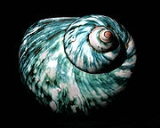
Turbo marmoratus
Encyclopedia
Turbo marmoratus, the marbled turban or great green turban, is a large species of marine
gastropod with a calcareous
operculum
in the family
Turbinidae
, the turban snails. These large snails live in tropical reefs
in the Indian
and western Pacific
oceans. They are nocturnal and feed on algae
.http://www.nhm.ac.uk/nature-online/species-of-the-day/biodiversity/endangered-species/turbo-marmoratus/index.html
The shell of marbled turbans is used as a source of nacre
. Also, the large opercula of Turbo marmoratus have been used as paperweights.http://www.manandmollusc.net/operculum_paul.html.

Marine (ocean)
Marine is an umbrella term. As an adjective it is usually applicable to things relating to the sea or ocean, such as marine biology, marine ecology and marine geology...
gastropod with a calcareous
Calcareous
Calcareous is an adjective meaning mostly or partly composed of calcium carbonate, in other words, containing lime or being chalky. The term is used in a wide variety of scientific disciplines.-In zoology:...
operculum
Operculum (gastropod)
The operculum, meaning little lid, is a corneous or calcareous anatomical structure which exists in many groups of sea snails and freshwater snails, and also in a few groups of land snails...
in the family
Family (biology)
In biological classification, family is* a taxonomic rank. Other well-known ranks are life, domain, kingdom, phylum, class, order, genus, and species, with family fitting between order and genus. As for the other well-known ranks, there is the option of an immediately lower rank, indicated by the...
Turbinidae
Turbinidae
Turbinidae, the turban snails, are a family of small to large marine gastropods. Turbinidae have a strong, thick calcareous operculum readily distinguishing them from the somewhat similar Trochidae or top snails, which have a corneous operculum...
, the turban snails. These large snails live in tropical reefs
Coral reef
Coral reefs are underwater structures made from calcium carbonate secreted by corals. Coral reefs are colonies of tiny living animals found in marine waters that contain few nutrients. Most coral reefs are built from stony corals, which in turn consist of polyps that cluster in groups. The polyps...
in the Indian
Indian Ocean
The Indian Ocean is the third largest of the world's oceanic divisions, covering approximately 20% of the water on the Earth's surface. It is bounded on the north by the Indian Subcontinent and Arabian Peninsula ; on the west by eastern Africa; on the east by Indochina, the Sunda Islands, and...
and western Pacific
Pacific Ocean
The Pacific Ocean is the largest of the Earth's oceanic divisions. It extends from the Arctic in the north to the Southern Ocean in the south, bounded by Asia and Australia in the west, and the Americas in the east.At 165.2 million square kilometres in area, this largest division of the World...
oceans. They are nocturnal and feed on algae
Algae
Algae are a large and diverse group of simple, typically autotrophic organisms, ranging from unicellular to multicellular forms, such as the giant kelps that grow to 65 meters in length. They are photosynthetic like plants, and "simple" because their tissues are not organized into the many...
.http://www.nhm.ac.uk/nature-online/species-of-the-day/biodiversity/endangered-species/turbo-marmoratus/index.html
The shell of marbled turbans is used as a source of nacre
Nacre
Nacre , also known as mother of pearl, is an organic-inorganic composite material produced by some mollusks as an inner shell layer; it is also what makes up pearls. It is very strong, resilient, and iridescent....
. Also, the large opercula of Turbo marmoratus have been used as paperweights.http://www.manandmollusc.net/operculum_paul.html.


